
The Wampfler Coat-of-Arms
by John E. Wampler
Last update: 9/19/'11
 |
The Wampfler Coat-of-Arms
|
Section 1.2
Last update: 9/19/'11 |
The following discussion includes some of the language of heraldry, the science of the armorial bearings (or arms) which were used from the 12th century onward to represent individuals and communities. Specific terms of the science are given in boldface.
Except for England, arms were widely used in Europe and especialy in the Swiss Federation by people in all classes and stations. Arms were adopted by individuals, family groups, cities and states. The "right to bear arms" extended to everyone, but not everyone did. For more information on Heraldry and arms see the reference list at the end of this discussion. The examples of civic arms given below were taken from the International Civic Arms web site maintained by Ralf Hartemink. The photograph of the Wampfler coat-of-arms was provided by Dr. John M. Wampler.
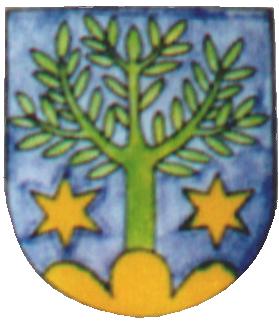
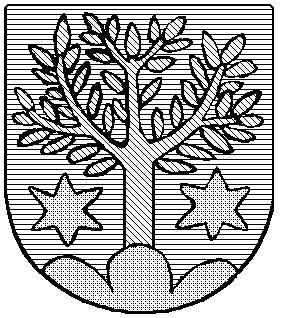
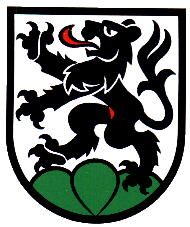 The Wampfler coat of arms shown in the accompanying photograph (above Left) is found
on the wall of the city building in Lenk, Switzerland, and was photographed for us by Dr. John M. Wampler of Nashville, TN.
The Wampfler coat of arms shown in the accompanying photograph (above Left) is found
on the wall of the city building in Lenk, Switzerland, and was photographed for us by Dr. John M. Wampler of Nashville, TN. Its base color (Tinctures in the language of Heraldry) is blue (Azure). At the base is a yellow (Or) symbol which is commonly found in the Canton, district and municipality arms (see link) as a symbol of the mountains. A typical coat-of-arms containing this symbol is that of the Schwarzenburg District (Bern Canton) shown to the left. This same symbol for mountains was found in the 15th century arms of the Vaud Canton except in black (Sable). It is a recurring symbol in Swiss Heraldry.
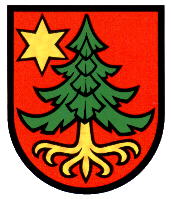 The second common symbol from Swiss Heraldry found in the Wampfler arms is the six pointed star.
Indeed, it is the prominent symbol in
the arms of many cities, districts and Cantons. It is also found on several of the other family arms
displayed in the Lenk city building (e.g. Freidig, Jaggi and Ludi). The arms of the Trachselwald district (Bern Canton)
dating to the 17th century are shown to the right. Multiple stars as in the Wampfler arms are also found in the
arms of some municipalities such as Oberstocken, Schangnau and Schattenhalb where they are said to represent
the villages within them. Perhaps in the Wampfler arms, this combination stands
for Deimtigen and Zwissenfluh since Wampflen is located between these villages
(see map).
The second common symbol from Swiss Heraldry found in the Wampfler arms is the six pointed star.
Indeed, it is the prominent symbol in
the arms of many cities, districts and Cantons. It is also found on several of the other family arms
displayed in the Lenk city building (e.g. Freidig, Jaggi and Ludi). The arms of the Trachselwald district (Bern Canton)
dating to the 17th century are shown to the right. Multiple stars as in the Wampfler arms are also found in the
arms of some municipalities such as Oberstocken, Schangnau and Schattenhalb where they are said to represent
the villages within them. Perhaps in the Wampfler arms, this combination stands
for Deimtigen and Zwissenfluh since Wampflen is located between these villages
(see map).
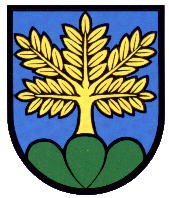 The final symbol (or Charge) on the Wampfler coat-of-arms is the central green (Vert)
plant. While plant charges are not common on other arms, they seem to be relatively
freely used on the Swiss arms. There are a number of tree like symbols on the arms
of other families in Lenk as well as in the arms of various districts (e.g. Laupen since 1294),
municipalities (e.g. Langnau im Emmental since 1674). The closest charge to the one in the Wampfler arms
is the recent (1929) ash tree symbol in the arms of Niederosch (left).
The final symbol (or Charge) on the Wampfler coat-of-arms is the central green (Vert)
plant. While plant charges are not common on other arms, they seem to be relatively
freely used on the Swiss arms. There are a number of tree like symbols on the arms
of other families in Lenk as well as in the arms of various districts (e.g. Laupen since 1294),
municipalities (e.g. Langnau im Emmental since 1674). The closest charge to the one in the Wampfler arms
is the recent (1929) ash tree symbol in the arms of Niederosch (left).
In the rules of blazon (the language of arms), the metals (white/silver and yellow/gold) are not normally placed on each other nor are the other colours (red, blue, black and green) place on each other. The rule requires a metal on a colour or vica versa. This rule is obviously violated in the Wampfler arms with the green plant place on the blue field.
The tinctures of heraldry stand for a wide range of shades and tints of the associated colors. As a result the same arms can be represented in very different tones. The metals Or and Argent might vary from gold to yellow to orange and white to silver to gray respectively. The colours, Azure (blue), Sable (black), Vert (green) Gules (red) and Purpure (purple) might similarly vary in any given representation. Gules might be vermilion in one case and garnet red in another. In the early 17th century engravers in Antwerp perfected a simple system of hatching to represent the seven heraldic tinctures (dots for Or, horizontal lines for Azure, diagonal lines top-to-bottom, left-to-right for Verd, etc.). Thus, the Wampfler arms would be represented in black and white or in an engraving as shown on the right side at the top of the page.
Michel Pastoureau (1996) Heraldly, An Introduction to a Noble Tradition (English Translation, (c) 1997), Harry N. Abrams, Inc., New York.Swiss coats-of arms from the International Civic Arms web site. This site is much larger and has a different organization than when this page was first written. Please refer to the site via the page linked her for individual Coats of Arms.
Pimbley's Dictionary of Heraldry from the Heraldry on the Internet web site.
A discusion of the symbols of Heraldry taken W. Cecil Wade's "The Symbolisms of Heraldry or A Treatise on the Meanings and Derivations of Armorial Bearings". Published in London in 1898 from the Heraldry on the Internet web site.
A pdf document discussing Coats of Arms from the Hostetler web site.